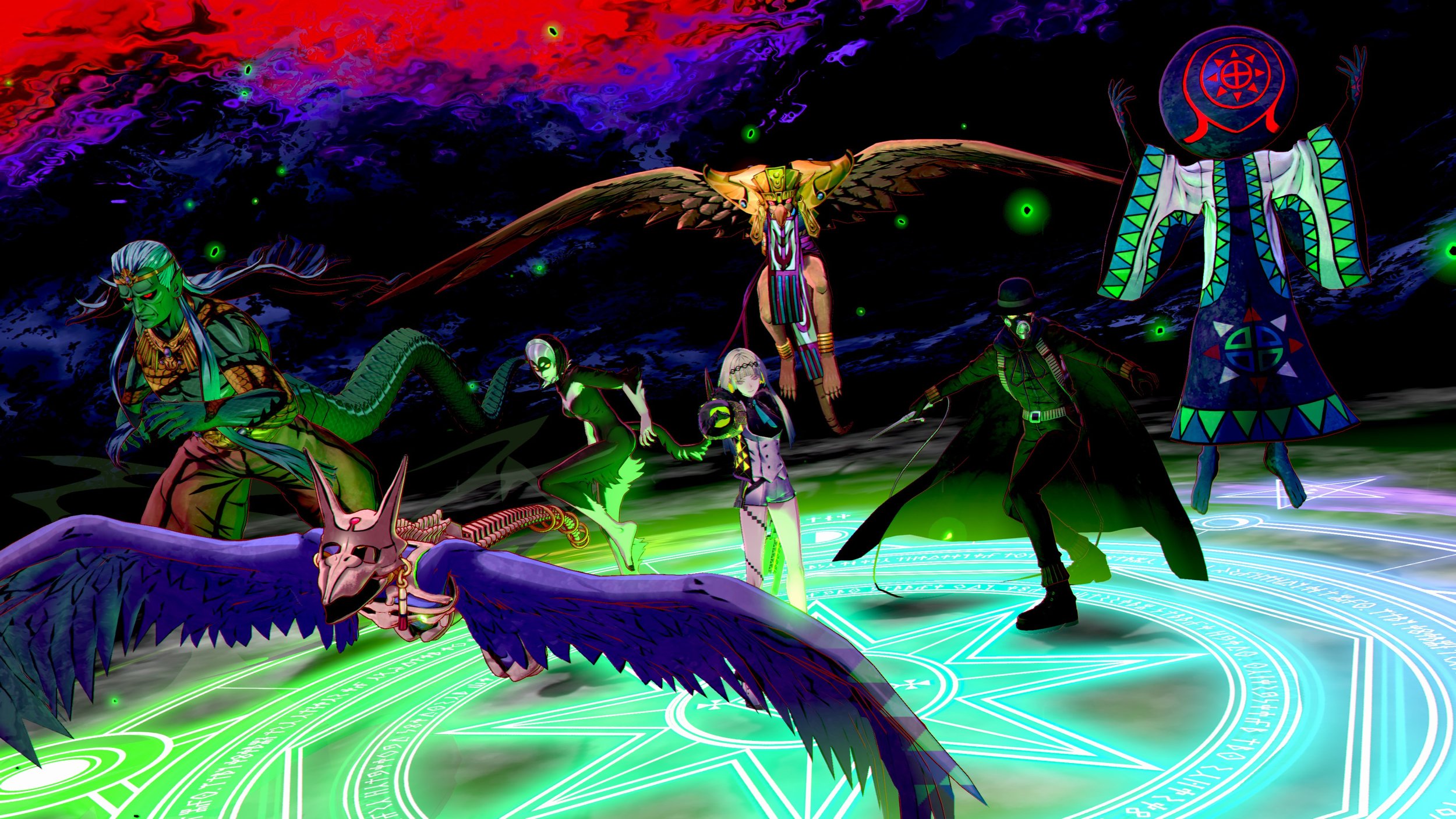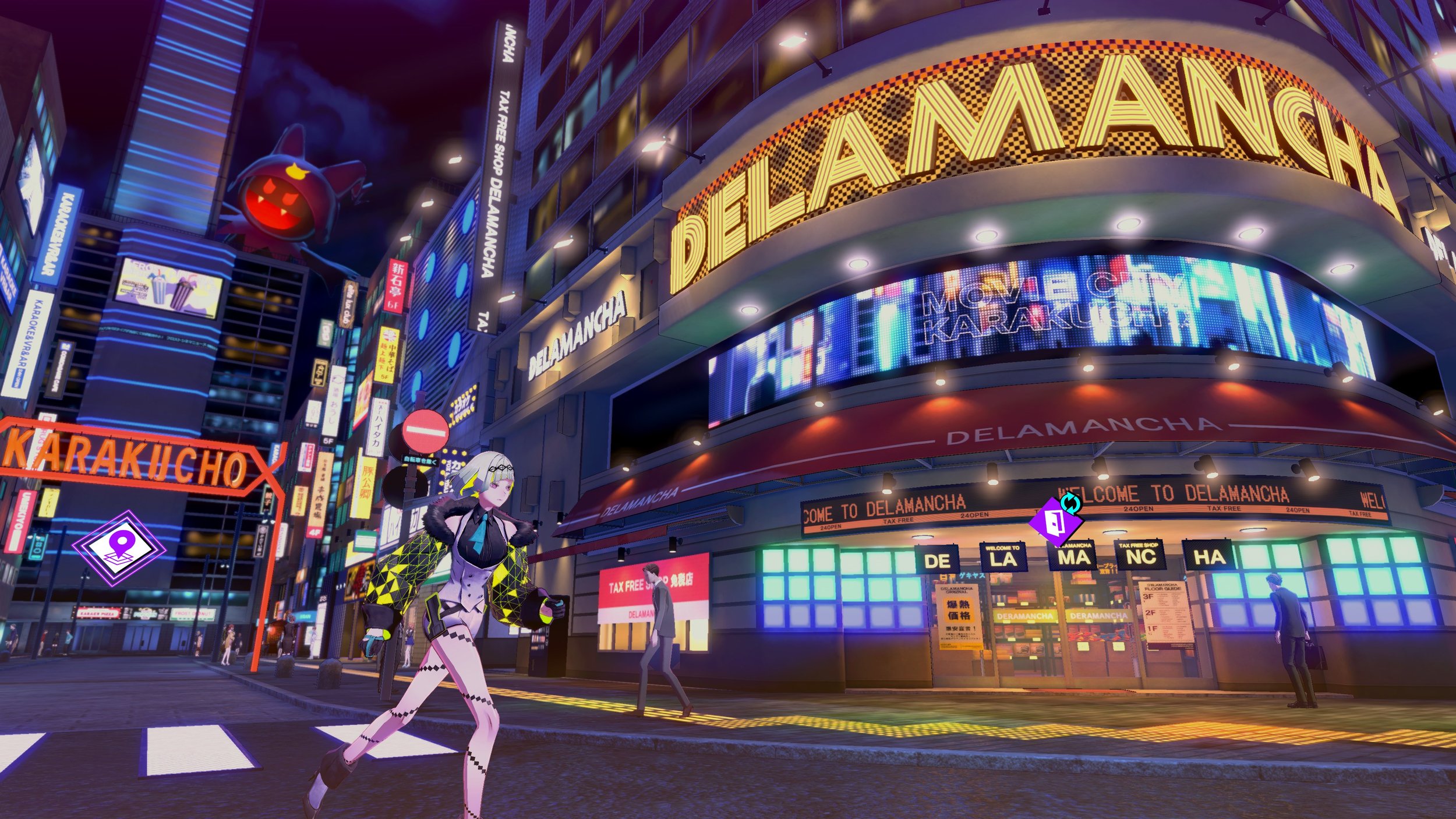Soul Hackers 2 - Review

The Shin Megami Tensei universe stretches into many different worlds, timelines and places. From post-apocalyptic worlds torn between demons and angels in Shin Megami Tensei, the horrors of High School in Persona. Soul Hackers takes a slightly different path. The glimmer of neon lights, technological futures and ridiculous weapons that summon demons.
Soul Hackers 2 is a supernatural RPG based in the Shin Megami Tensei universe. It tries something very different to other games, that are connected to the larger SMT universe. You play as Ringo, a female presenting protagonist who actually has a voice. Gone are the silent protagonists found within other games from across the series, and praise be given to the arrival of the voiced and personality filled protagonist of the future.
Soul Hackers 2 is without a doubt one of the nicest looking games from the developer, in fact it would be on par with Persona 5 in visual fidelity, with the option to pick between performance or Quality mode. I would definitely recommend playing in quality mode on consoles, as the performance boost is almost a non-factor compared to the hyper increase in visual impressiveness. Moreover it is very impressive, that despite the game being made in the Unity engine, it contains none of the typical stereotypical jank or downgrade in graphical quality. In fact, Soul Hackers 2 is a prime example of the power that a more user-focused design engine, is still being proficient of putting out, meaning an impressively designed game without sacrificing visuals for the sake of such.
What cannot be understated is the effective use of the cyberpunk futuristic setting of the game, especially when compared to that of Shin Megami Tensei 5 and its rather bland apocalyptic setting. Whilst there was a fundamental reason that setting, the result of which struggled to engage the player with the world, which was not ideal for the very long stretches of grinding combat that was ahead. Soul Hackers 2 on the other hand, feels full of life, with plenty of folks to interact with, demons with personality and different behaviours, in addition to the well-developed NPCs. Soul Hackers 2 definitely has leaned into the good parts of what makes Persona so popular, whilst leaving behind the drier parts of Shin Megami Tensei, that can make it feel somewhat dated in the modern-day RPG landscape.
There is effective use of locations in this, rather than use an open world or a down-graded simplified overworld map, Soul Hackers 2 uses a location-based system that allows you to choose where you want to go. It means that when you are slogging away at side quests or looking to go to particular stores, you can get to them almost instantly, without having to traverse a somewhat confusing world. For RPGs of this style, with a focus on dungeon crawling, a list of locations for world locations is a vastly smarter way of giving you access to the different areas.
The downside here, which is something that most games of the Shin Megami Tensei extended universe suffer from, is that dungeons are the bread and butter of your diversity. Persona 5 in particularly excelled by having very intricate and unique dungeons, whilst staying within their castle aesthetic. Shin Megami Tensei 5 made use of the sprawling and repetitive environment as a pseudo-open world to replace the idea of a traditional dungeon. Soul Hackers 2 finds a sort of a middle point. Unfortunately with the game taking place in a real-world locale, the dungeons too are representative of real-world locations. Outside of the Soul Matrix, you’ll find yourself navigating a loading dock, or a subway system, perhaps the inside of the building may prove more interesting.
In a world that features a super colourful and neon light covered city, the dungeons feel like they miss the mark. A reverse would have been a far more interesting aesthetic to work with. Boring locations to get missions from, whilst having super colourful and over the top dungeons to play in. The Soul Matrix bucks the trend a little bit, but not enough to really make a major change. Instead of bland locations, the Soul Matrix is a digital world of bland white squares and blocks, devoid of human design. Whilst lore-wise this makes perfect sense, in terms of exploring it makes the deep side-quest heavy dungeon incredibly boring to spend long periods of time inside.
Interestingly, unlike Shin Megami Tensei and Persona, Soul Hackers 2 isn’t going to hold your life hostage for the next six months. If you decide to do all the side content, you will definitely be looking at an experience upwards of 60 hours. However if you are just focused on the main story and progressing the game Soul Hackers 2 will probably top out around 30 hours’ worth of game. A longer game by modern standards yes, but in terms of a Shin Megami Tensei spin-off RPG a much shorter game overall. A big upside is playing on anything below the hardest difficult, you’ll find yourself with very little to no reason to grind. Experience is always more generous when fighting appropriate enemies. The combat itself is far more focused on using effective abilities than being overpowered, so smart play is rewarded with being able to progress without a grind.
On that point, the combat in Soul Hackers 2 takes the good parts of Shin Megami Tensei and Persona, whilst doing away with the frivolous additions that make it a little bit cumbersome. Bar status effects like sleep, you won’t lose turns by getting hit by an attack that is super effective or critical damage. You won’t get extra turns by using super effective abilities, but you’ll start a stack of boosts. At the end of your turn, you’ll inflict an ‘Area of Effect’ attack, that increases in damage corresponding to the stacks you have obtained. This small tweak to the combat system makes it feel far less unfair when you get slapped with an enemy that can punish your current setup of demons. It makes for a far more strategy driven style of combat, based more on effective use of super effective/not effective elemental system rather than being totally linked to levels.
The game does a good job of introducing new mechanics unique to the game, such as Soul level. A good design choice was to introduce these mechanics when they make storyline logical sense, but without overloading you with information about the mechanic that you wouldn’t realistically actually know yet. Mechanics are often introduced when story relevant and then later on when the mechanic actually comes into effect gameplay-wise. It leads to a far more intuitive integration of sub-systems that makes them feel natural rather than forced.
In terms of story Soul Hackers 2 is nothing fancy, not taking too many risks on attempting to be too over the top. A story of underground Japanese societies at war over vaguely explained differences. You are AI cyborgs sent to stop the end of the world, and in doing ‘Soul Hacks’ returning people to life who can help stop the end of the world. Soul Hackers 2 is a little more supernatural than Shin Megami Tensei’s over-done post-apocalyptic world, without being as anime crazy as Persona tends to be. It finds a nice middle niche without being too offensively repetitive.
Soul Hackers 2 is a fun, very visually impressive RPG that takes the good parts of the larger universe, whilst leaving behind some of the arduous and overdone aspects that refuse to be left in the past. Whilst nothing standout storyline wise, the changes to gameplay and quality of life additions make it stand out from Shin Megami Tensei and Persona. The world and environments feel like they didn’t take full advantage of the settings potential, but the changes in common tropes go a long way in making the game enjoyable. Soul Hackers 2 is a solid mid-length RPG, that fans of Shin Megami Tensei and Persona will likely have a good time with. There is nothing that stands out as particularly wrong with the game, but in today’s gaming landscape mediocrity is sometimes worse than being bad.
The Score
8.5
Review code provided by Atlus
The Pros
+Visually impressive
+Combat changes are enjoyable
+Good location design
+A non-silent protagonist
The Cons
-Boring dungeons in comparison
-Non-unique story
-Missed opportunity with potential for exciting dungeons
-Soul Matrix is a grind-fest









